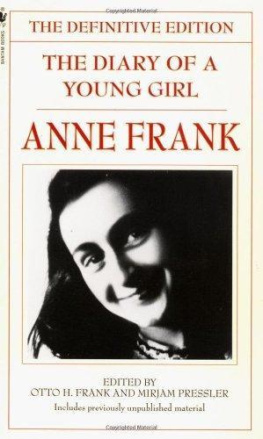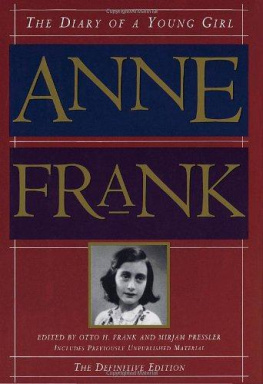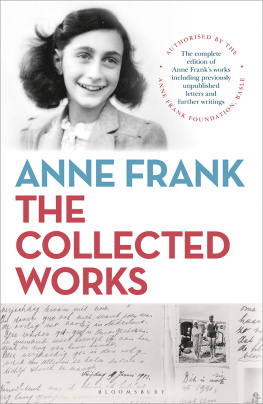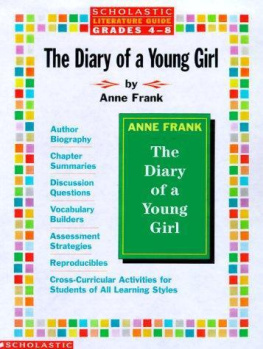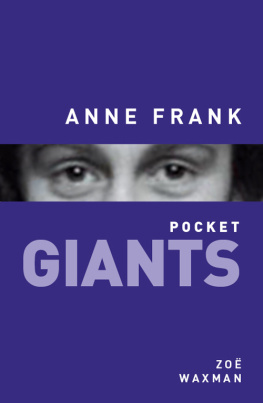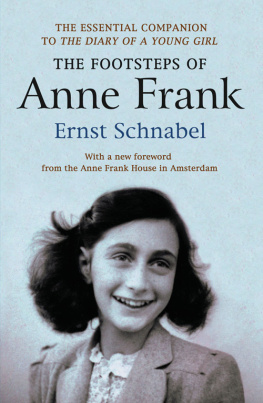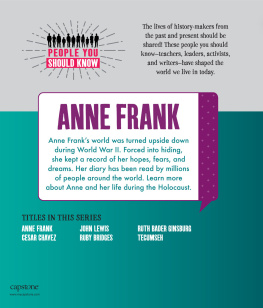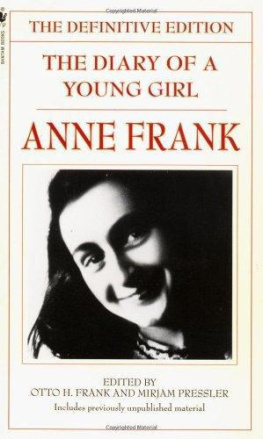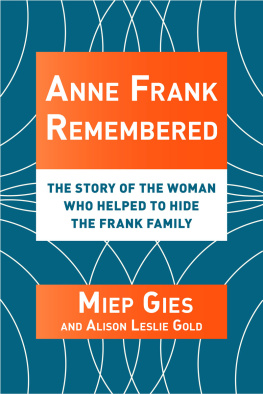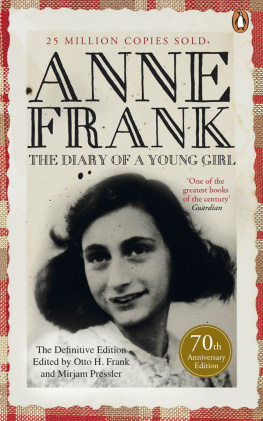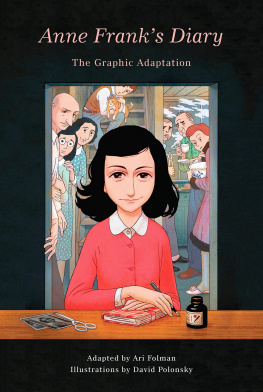Anne Frank - The Diary of a Young Girl: The Definitive Edition
Here you can read online Anne Frank - The Diary of a Young Girl: The Definitive Edition full text of the book (entire story) in english for free. Download pdf and epub, get meaning, cover and reviews about this ebook. year: 2011, publisher: Bantam, genre: Non-fiction. Description of the work, (preface) as well as reviews are available. Best literature library LitArk.com created for fans of good reading and offers a wide selection of genres:
Romance novel
Science fiction
Adventure
Detective
Science
History
Home and family
Prose
Art
Politics
Computer
Non-fiction
Religion
Business
Children
Humor
Choose a favorite category and find really read worthwhile books. Enjoy immersion in the world of imagination, feel the emotions of the characters or learn something new for yourself, make an fascinating discovery.

- Book:The Diary of a Young Girl: The Definitive Edition
- Author:
- Publisher:Bantam
- Genre:
- Year:2011
- Rating:3 / 5
- Favourites:Add to favourites
- Your mark:
- 60
- 1
- 2
- 3
- 4
- 5
The Diary of a Young Girl: The Definitive Edition: summary, description and annotation
We offer to read an annotation, description, summary or preface (depends on what the author of the book "The Diary of a Young Girl: The Definitive Edition" wrote himself). If you haven't found the necessary information about the book — write in the comments, we will try to find it.
The Diary of a Young Girl: The Definitive Edition — read online for free the complete book (whole text) full work
Below is the text of the book, divided by pages. System saving the place of the last page read, allows you to conveniently read the book "The Diary of a Young Girl: The Definitive Edition" online for free, without having to search again every time where you left off. Put a bookmark, and you can go to the page where you finished reading at any time.
Font size:
Interval:
Bookmark:
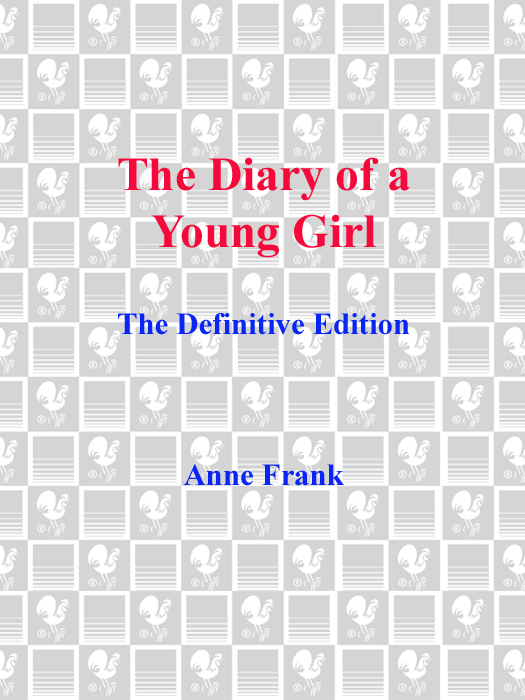
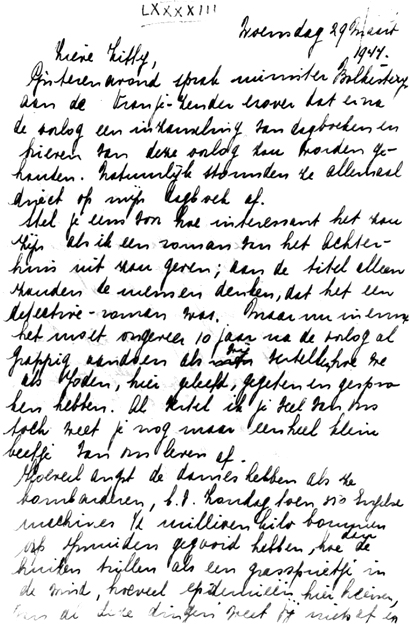
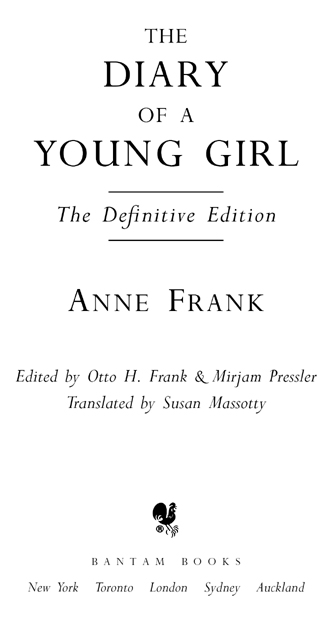
This edition contains the complete text of the original hardcover edition. NOT ONE WORD HAS BEEN OMITTED.
The translator is grateful to Stacy Knecht for her editorial assistance and to Nancy Forest-Flier for her translation of the poems on .
THE DIARY OF A YOUNG GIRL: THE DEFINITIVE EDITION
A Bantam Book
PUBLISHING HISTORY
The Diary of a Young Girl: The Definitive Edition was originally published in hardcover by Doubleday in March 1995. The Anchor Books trade edition was published in March 1996.
Bantam edition/March 1997
Copyright 1991 by The Anne FrankFonds, Basel, Switzerland English translation copyright 1995 by Doubleday, a division of Random House, Inc.
All rights reserved.
Library of Congress Catalog Card Number: 94-41379.
No part of this book may be reproduced or transmitted in any form or by any means, electronic or mechanical, including photocopying, recording, or by any information storage and retrieval system, without permission in writing from the publisher. For information address: Doubleday.
eISBN: 978-0-307-80753-3
Bantam Books are published by Bantam Books, a division of Random House, Inc. Its trademark, consisting of the words Bantam Books and the portrayal of a rooster, is Registered in U.S. Patent and Trademark Office and in other countries. Marca Registrada. Bantam Books, 1540 Broadway, New York, New York 10036.
v3.1
Anne Frank kept a diary from June 12, 1942, to August 1, 1944. Initially, she wrote it strictly for herself. Then, one day in 1944, Gerrit Bolkestein, a member of the Dutch government in exile, announced in a radio broadcast from London that after the war he hoped to collect eyewitness accounts of the suffering of the Dutch people under the German occupation, which could be made available to the public. As an example, he specifically mentioned letters and diaries.
Impressed by this speech, Anne Frank decided that when the war was over she would publish a book based on her diary. She began rewriting and editing her diary, improving on the text, omitting passages she didnt think were interesting enough and adding others from memory. At the same time, she kept up her original diary. In the scholarly work The Diary of Anne Frank: The Critical Edition (1989), Annes first, unedited diary is referred to as version a, to distinguish it from her second, edited diary, which is known as version b.
The last entry in Annes diary is dated August 1, 1944. On August 4, 1944, the eight people hiding in the Secret Annex were arrested. Miep Gies and Bep Voskuijl, the two secretaries working in the building, found Annes diaries strewn all over the floor. Miep Gies tucked them away in a desk drawer for safekeeping. After the war, when it became clear that Anne was dead, she gave the diaries, unread, to Annes father, Otto Frank.
After long deliberation, Otto Frank decided to fulfill his daughters wish and publish her diary. He selected material from versions a and b, editing them into a shorter version later referred to as version c. Readers all over the world know this as The Diary of a Young Girl.
In making his choice, Otto Frank had to bear several points in mind. To begin with, the book had to be kept short so that it would fit in with a series put out by the Dutch publisher. In addition, several passages dealing with Annes sexuality were omitted; at the time of the diarys initial publication, in 1947, it was not customary to write openly about sex, and certainly not in books for young adults. Out of respect for the dead, Otto Frank also omitted a number of unflattering passages about his wife and the other residents of the Secret Annex. Anne Frank, who was thirteen when she began her diary and fifteen when she was forced to stop, wrote without reserve about her likes and dislikes.
When Otto Frank died in 1980, he willed his daughters manuscripts to the Netherlands State Institute for War Documentation in Amsterdam. Because the authenticity of the diary had been challenged ever since its publication, the Institute for War Documentation ordered a thorough investigation. Once the diary was proved, beyond a shadow of a doubt, to be genuine, it was published in its entirety, along with the results of an exhaustive study. The Critical Edition contains not only versions a, b and c, but also articles on the background of the Frank family, the circumstances surrounding their arrest and deportation, and the examination into Annes handwriting, the document and the materials used.
The Anne FrankFonds (Anne Frank Foundation) in Basel (Switzerland), which as Otto Franks legal heir had inherited his daughters copyrights, then decided to have a new, expanded edition of the diary published for general readers. This new edition in no way affects the integrity of the old one originally edited by Otto Frank, which brought the diary and its message to millions of people. The task of compiling the expanded edition was given to the writer and translator Mirjam Pressler. Otto Franks original selection has now been supplemented with passages from Annes a and b versions. Mirjam Presslers definitive edition, approved by the Anne FrankFonds, contains approximately 30 percent more material and is intended to give the reader more insight into the world of Anne Frank.
In 1998 the existence of five previously unknown pages of the diary came to light. Now, with the permission of the Anne FrankFonds in Basel, a long passage dated February 8, 1944, has been added to the end of the already-existing entry of that date. A short alternative to the entry of June 20, 1942, has not been included here because a more detailed version of it is already part of the diary. Furthermore, in line with recent findings, the entry of November 7, 1942, has been moved to October 30, 1943. For more information, the reader is referred to the revised Critical Edition.
In writing her second version (b), Anne invented pseudonyms for the people who would appear in her book. She initially wanted to call herself Anne Aulis, and later Anne Robin. Otto Frank opted to call his family by their own names and to follow Annes wishes with regard to the others. Over the years, the identity of the people who helped the families in the Secret Annex has become common knowledge. In this edition, the helpers are now referred to by their real names, as they so justly deserve to be. All other persons are named in accordance with the pseudonyms in The Critical Edition. The Institute for War Documentation has arbitrarily assigned initials to those persons wishing to remain anonymous.
The real names of the other people hiding in the Secret Annex are:
T HE VAN P ELS F AMILY
(from Osnabrck, Germany):
Auguste van Pels (born September 9, 1900)
Hermann van Pels (born March 31, 1898)
Peter van Pels (born November 8, 1926)
Called by Anne, in her manuscript: Petronella, Hans and Alfred van Daan; and in the book: Petronella, Hermann and Peter van Daan.
F RITZ P FEFFER
(born April 30, 1889, in Giessen, Germany):
Called by Anne, in her manuscript and in the book: Albert Dussel.
Font size:
Interval:
Bookmark:
Similar books «The Diary of a Young Girl: The Definitive Edition»
Look at similar books to The Diary of a Young Girl: The Definitive Edition. We have selected literature similar in name and meaning in the hope of providing readers with more options to find new, interesting, not yet read works.
Discussion, reviews of the book The Diary of a Young Girl: The Definitive Edition and just readers' own opinions. Leave your comments, write what you think about the work, its meaning or the main characters. Specify what exactly you liked and what you didn't like, and why you think so.

